
Resources
Browse our full library of in-depth resources and publications
The PacWastePlus programme team is committed to producing meaningful and valuable publications and resources that provides guidance for improving waste management in the Pacific
Search
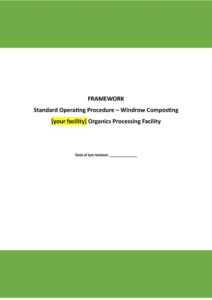
Resource Template
Standard Operating Procedure – Windrow Composting [your facility] Organics Processing Facility
This Framework Standard Operating Procedure (SOP) can be downloaded and customised by operators of medium sized Windrow Compost Facilities, receiving 5-20 tonnes of organic material per week. The SOP can be customised to the local context, and used to guide the effective composting process, providing supervisors and staff the background and guidance on activities to operate and run a Windrow Compost facility safely, effectively, and efficiently. The SOP is split into three sections: • Part 1 – Quick Guide • Part 2 – Stages of Composting • Part 3 – Appendix / Further Reading The SOP is designed to be customised with all areas in yellow designed to prompt an update and tailoring to the local situation.
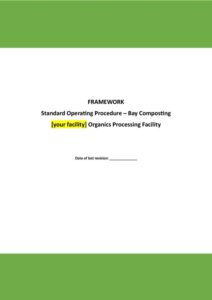
Resource Template
Bay Composting [your facility] Organics Processing Facility: framework standard operating procedure (SOP)
This Framework Standard Operating Procedure (SOP) can be downloaded and customised by operators of medium sized Bay Compost Facilities, receiving 5-20 tonnes of organic material per week. The SOP can be customised to the local context, and used to guide the effective composting process, providing supervisors and staff the background and guidance on activities to operate and run a Bay Compost facility safely, effectively, and efficiently. The SOP is split into three sections: • Part 1 – Quick Guide • Part 2 – Stages of Composting • Part 3 – Appendix / Further Reading The SOP is designed to be customised with all areas in yellow designed to prompt an update and tailoring to the local situation.
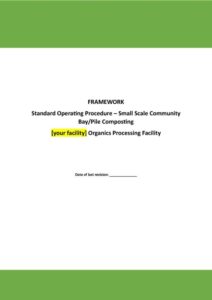
Resource Template
Small Scale Community Bay/Pile Composting [your facility] Organics Processing Facility: framework standard operating procedure (SOP)
This Framework Standard Operating Procedure (SOP) can be downloaded and customised by operators of Small-Scale 3-Bay / Small Pile Composting Facility, receiving less than 100 kg (approximately two wheelbarrows) of organic material per week. The SOP can be customised to the local context, and used to guide the effective operation of a small facility, to ensure the efficient recycling of organic material into compost for soil enrichment. The SOP can be used by households, communities, and small-scale fruit and vegetable growers seeking to establish a compost site, using simple tools and manual labour.
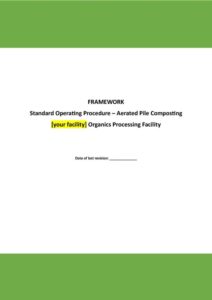
Resource Template
Aerated Pile Composting [your facility] Organics Processing Facility: framework standard operating procedure (SOP)
This Framework Standard Operating Procedure (SOP) can be downloaded and customised by operators of medium sized Aerated Static Pile Compost Facilities, receiving 5-20 tonnes of organic material per week. The SOP can be customised to the local context, and used to guide the effective composting process, providing supervisors and staff the background and guidance on activities to operate and run a Aerated Static Pile Compost facility safely, effectively, and efficiently. The SOP is split into three sections: • Part 1 – Quick Guide • Part 2 – Stages of Composting • Part 3 – Appendix / Further Reading The SOP is designed to be customised with all areas in yellow designed to prompt an update and tailoring to the local situation.
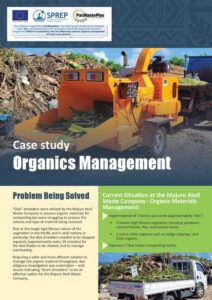
Case Study
Case Study Organic Management
Due to the tough high fibrous nature of the vegetation in the Pacific and in atoll nations in particular, commonly used “disk shredders” often need to be stopped regularly (approximately every 30 minutes) for the disk blades to be cleared, and to manage overheating.
Seeking safer and more efficient processing , PacWastePlus and the Republic of Marshal Islands procured a “drum shredder” to process their organic material – approximately 7 tonnes per week. This case study describes the performance of the drum shredder, with main findings include:
Power and durability – the drum shredder can handle tougher materials and is less prone to wear and tear.
Faster processing - the rotary drum design allows for continuous and more efficient shredding, which leads to faster processing speeds.
Safer processing - tough high fibrous material does not get “caught up” in blades and therefore does not require staff to reach inside and between the disks
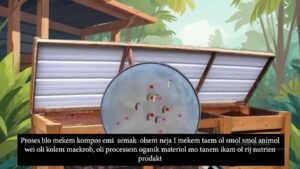
Composting
Establishing a compost facility in your community (with subtitles Vanuatuan languages)
Currently much of the waste going to community dumps is organic materials (40-65%) which, when mixed in a dump with other material like plastics and nappies etc, can cause soil and water pollution, odour, and methane (climate change effects).
Converting this material to compost can benefit communities – by improving soil quality, increasing crop yield, assisting climate resistance, and saving money (replace imported fertilizers).
This animation assists communities to establish a community scale compost program (for communities up to 50 households) – briefly covering topics of:
1. importance of organic materials management
2. how to make a compost bin
3. how to add items: understanding the “carbon / nitrogen ratio”, and ensuring correct balance of air, food and water
4. how to use compost
Organic materials are not a waste – they are a resource!
For more details in establishing a community compost facility please visit the factsheet:
https://pacwasteplus.org/resources/how-do-i-compost-a-guide-for-community-composting/
Available in 5 other languages - Tongan, Chuuk, Pidgin etc...
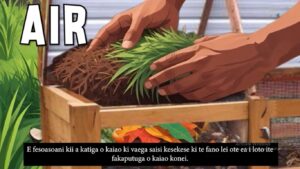
Composting
Establishing a compost facility in your community (with subtitles in Tuvaluan language)
Currently much of the waste going to community dumps is organic materials (40-65%) which, when mixed in a dump with other material like plastics and nappies etc, can cause soil and water pollution, odour, and methane (climate change effects).
Converting this material to compost can benefit communities – by improving soil quality, increasing crop yield, assisting climate resistance, and saving money (replace imported fertilizers).
This animation assists communities to establish a community scale compost program (for communities up to 50 households) – briefly covering topics of:
1. importance of organic materials management
2. how to make a compost bin
3. how to add items: understanding the “carbon / nitrogen ratio”, and ensuring correct balance of air, food and water
4. how to use compost
Organic materials are not a waste – they are a resource!
For more details in establishing a community compost facility please visit the factsheet:
https://pacwasteplus.org/resources/how-do-i-compost-a-guide-for-community-composting/
Available in 5 other languages - Tongan, Chuuk, Pidgin etc...
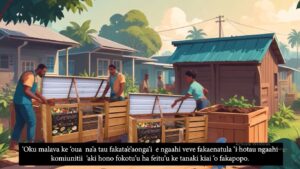
Composting
Establishing a compost facility in your community (with subtitles Tongan language)
Currently much of the waste going to community dumps is organic materials (40-65%) which, when mixed in a dump with other material like plastics and nappies etc, can cause soil and water pollution, odour, and methane (climate change effects).
Converting this material to compost can benefit communities – by improving soil quality, increasing crop yield, assisting climate resistance, and saving money (replace imported fertilizers).
This animation assists communities to establish a community scale compost program (for communities up to 50 households) – briefly covering topics of:
1. importance of organic materials management
2. how to make a compost bin
3. how to add items: understanding the “carbon / nitrogen ratio”, and ensuring correct balance of air, food and water
4. how to use compost
Organic materials are not a waste – they are a resource!
For more details in establishing a community compost facility please visit the factsheet:
https://pacwasteplus.org/resources/how-do-i-compost-a-guide-for-community-composting/
Available in 5 other languages - Tongan, Chuuk, Pidgin etc...
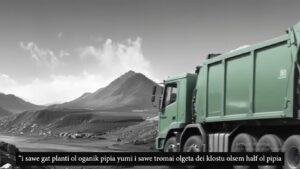
Composting
Establishing a compost facility in your community (with subtitles in PNG language)
Currently much of the waste going to community dumps is organic materials (40-65%) which, when mixed in a dump with other material like plastics and nappies etc, can cause soil and water pollution, odour, and methane (climate change effects).
Converting this material to compost can benefit communities – by improving soil quality, increasing crop yield, assisting climate resistance, and saving money (replace imported fertilizers).
This animation assists communities to establish a community scale compost program (for communities up to 50 households) – briefly covering topics of:
1. importance of organic materials management
2. how to make a compost bin
3. how to add items: understanding the “carbon / nitrogen ratio”, and ensuring correct balance of air, food and water
4. how to use compost
Organic materials are not a waste – they are a resource!
For more details in establishing a community compost facility please visit the factsheet:
https://pacwasteplus.org/resources/how-do-i-compost-a-guide-for-community-composting/
Available in 5 other languages - Tongan, Chuuk, Pidgin etc...
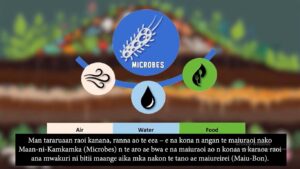
Composting
Establishing a compost facility in your community (with subtitles in Kiribati language)
Currently much of the waste going to community dumps is organic materials (40-65%) which, when mixed in a dump with other material like plastics and nappies etc, can cause soil and water pollution, odour, and methane (climate change effects).
Converting this material to compost can benefit communities – by improving soil quality, increasing crop yield, assisting climate resistance, and saving money (replace imported fertilizers).
This animation assists communities to establish a community scale compost program (for communities up to 50 households) – briefly covering topics of:
1. importance of organic materials management
2. how to make a compost bin
3. how to add items: understanding the “carbon / nitrogen ratio”, and ensuring correct balance of air, food and water
4. how to use compost
Organic materials are not a waste – they are a resource!
For more details in establishing a community compost facility please visit the factsheet:
https://pacwasteplus.org/resources/how-do-i-compost-a-guide-for-community-composting/
Available in 5 other languages - Tongan, Chuuk, Pidgin etc...
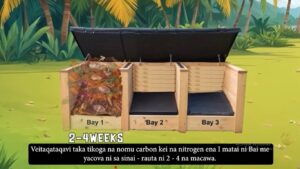
Composting
Establishing a compost facility in your coomunity (with subtitles Itaukei language)
Currently much of the waste going to community dumps is organic materials (40-65%) which, when mixed in a dump with other material like plastics and nappies etc, can cause soil and water pollution, odour, and methane (climate change effects).
Converting this material to compost can benefit communities – by improving soil quality, increasing crop yield, assisting climate resistance, and saving money (replace imported fertilizers).
This animation assists communities to establish a community scale compost program (for communities up to 50 households) – briefly covering topics of:
1. importance of organic materials management
2. how to make a compost bin
3. how to add items: understanding the “carbon / nitrogen ratio”, and ensuring correct balance of air, food and water
4. how to use compost
Organic materials are not a waste – they are a resource!
For more details in establishing a community compost facility please visit the factsheet:
https://pacwasteplus.org/resources/how-do-i-compost-a-guide-for-community-composting/
Available in 5 other languages - Chuuk, Tongan, Pidgin etc....
Newsletter Subscription
Would you like to subscribe to our quarterly programme newsletter-The Connection?
We care about the protection of your data. Read our Privacy Policy.
Newsletter Signup
To sign up to our newsletter, enter the information below and we will add you to our mailing list for all future regional and project updates.

